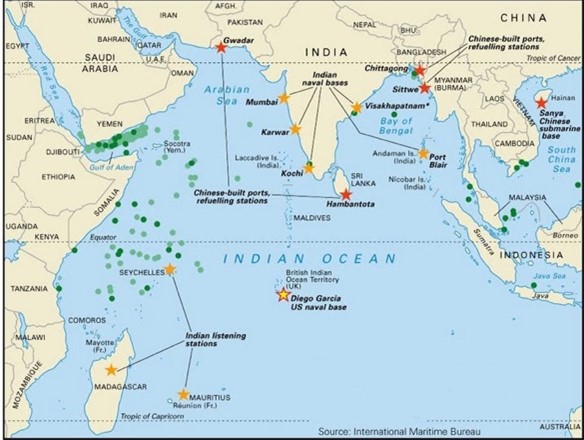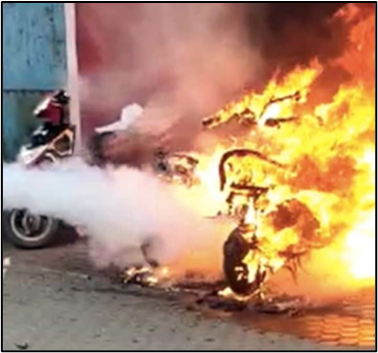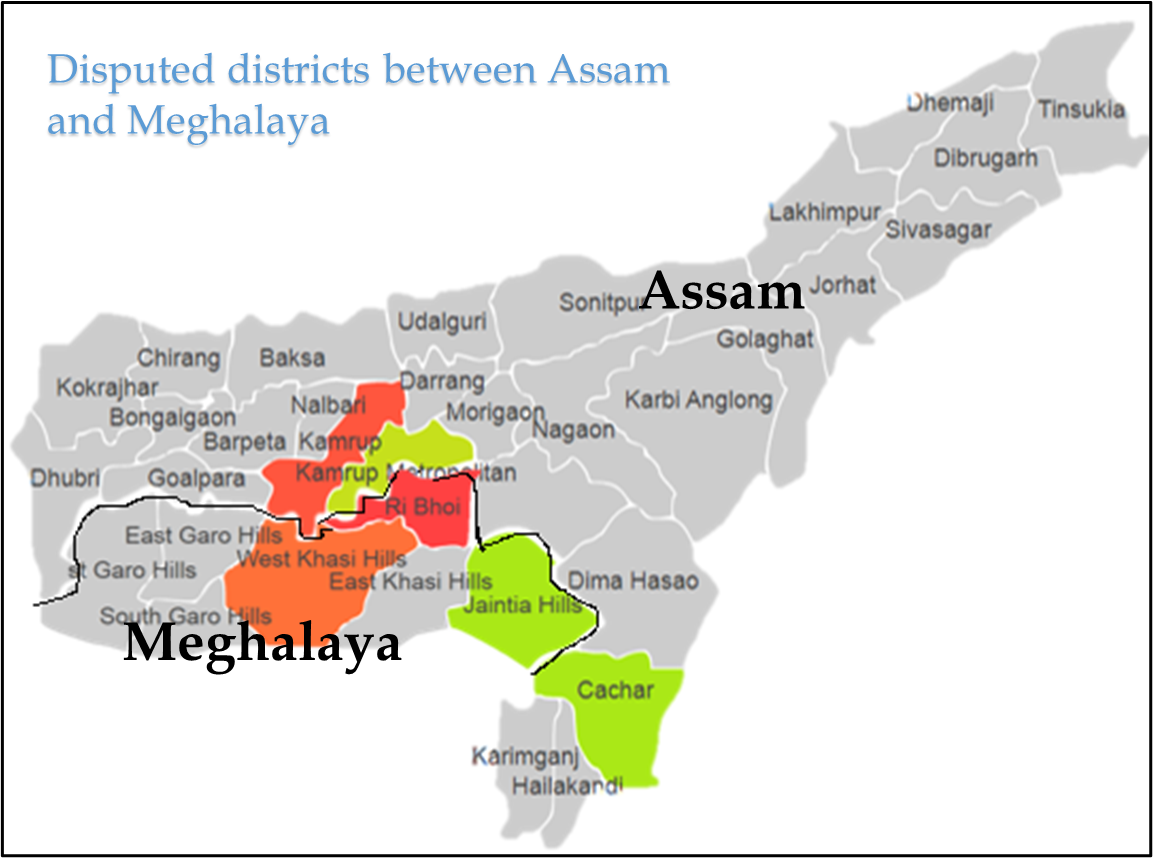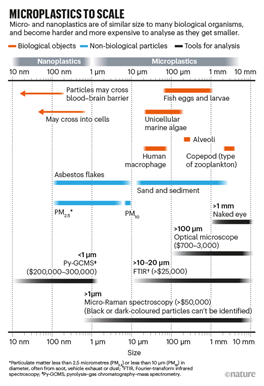Friday, 1st April 2022
AFSPA controlled areas reduced
In News
The Centre has significantly reduced the footprint of the Armed Forces Special Powers Act (AFSPA), 1958 in the Northeast, withdrawing it entirely from 23 districts in Assam; and partially from seven districts in Nagaland, six districts in Manipur, and one district in Assam.
About AFSPA
- The law Armed Forces Special Powers Act first came into effect in 1958 for Assam and Manipur to deal with the uprising in the Naga Hills, followed by the insurgency in Assam.
- It was first enforced in Manipur and later extended to other states.
- It can be imposed by the Centre or the Governor of a state, on the state or parts of it, after these areas are declared “disturbed’’ under Section 3 of the Act.
- Currently, the Union Home Ministry issues periodic “disturbed area” notification to extend the AFSPA only for Nagaland and Arunachal Pradesh, in districts bordering Assam.
- The notification for Manipur and Assam is issued by the State governments.
- Tripura in 2015 and Meghalaya in 2018 revoked the Act.
- Jammu and Kashmir has a separate J&K Armed Forces (Special Powers) Act, 1990.
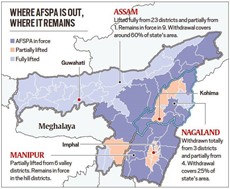
Where does AFSPA remain in force currently?
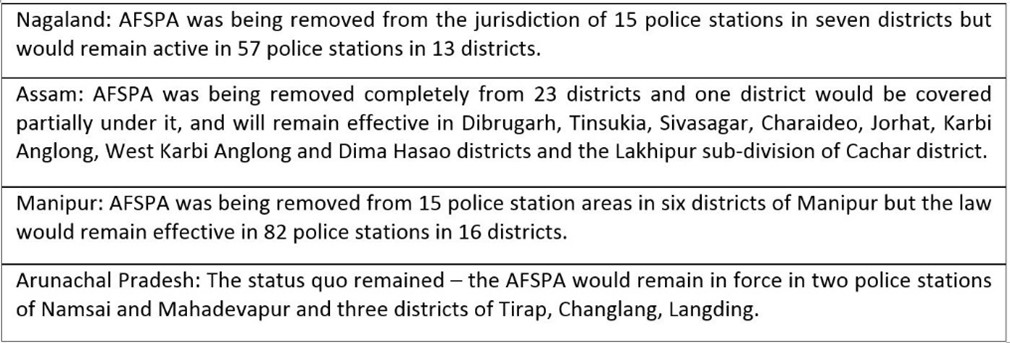
Reasons for the withdrawal
- Over the last two decades, various parts of the Northeast have seen a reduction in insurgencies.
- In Nagaland, all major groups — the NSCN(I-M) and Naga National Political Groups (NNPGs) — are at advanced stages of concluding agreements with the government.
- In Manipur, insurgency as well as heavy militarisation have been on the decline since 2012.
- In Nagaland, the killing of 14 villagers in Oting, Mon, is seen as having had a telling impact on reviving the demand to repeal AFSPA.
- After Oting, the Nagaland Assembly passed a resolution for the first time for repeal of AFSPA.
- AFSPA, which has been called draconian, gives sweeping powers to the armed forces.
- It gives unbridled power to the armed forces and the Central Armed Police Forces deployed to kill anyone acting in contravention of law, arrest and search any premises without a warrant and protection from prosecution and legal suits without the Central government’s sanction.
- Various incidents of violence have been recorded in the North-eastern states, under the guise of the law. Following a writ petition in 2012, Supreme court had set up a commission to scrutinise six of these cases, and the commission found all six to be fake encounters.
- The Northeast has lived under the shadow of AFSPA for nearly 60 years, creating psychological consequences, trauma and alienation of the people.
Withdrawal of AFSPA - long time in the making:
- In 2000, the activist Irom Sharmila began a hunger strike that would continue for 16 years against AFSPA in Manipur.
- In 2004, the then central government set up a five-member committee under former Supreme Court Justice Jeevan Reddy, which submitted its report in 2005 recommending the repeal of AFSPA.
- Subsequently, the Second Administrative Reforms Commission, headed by Veeerapa Moily, endorsed these recommendations.
- The move is expected to help demilitarise the region; it will lift restrictions of movements through check points and frisking of residents.
Sources:
Coral Bleaching - Edukemy Current Affairs
In News
Corals of Great Barrier Reef is currently going through another mass bleaching event.
About the News
- Although the great Barrier Reef have been suffering its fourth mass bleaching event since 2016, it is for the first time, the reefs of Great barrier have bleached under the cooling conditions of the natural La Nina weather pattern.
- When coral bleaches, it is not dead and can still recover if conditions improve. But it’s estimated to take up to 12 years if there’s no new disturbance in the meantime, such as a cyclone or another bleaching event.
- Given the reef has bleached six times since the late 1990s, alongside global climate trajectories, full reef recovery appears an unlikely scenario.

What are the factors responsible for death of a coral reef?
- About: When corals are stressed by changes in conditions such as temperature, light, or nutrients, they eject their zooxanthellae, single-celled algae that gives coral colour and energy, causing them to turn completely white.
- Water temperature: If water remains too warm for too long, corals will eventually die. But if the water temperature drops and the ultraviolet light becomes less intense, then the coral may recover and survive.
- Stress: If coral does survive a bleaching event, it is still impacted physiologically, as bleaching can slow growth rates and reduce reproductive capacity. Surviving colonies also become more susceptible to other challenges, such as disease.
- Resilience: Survival also depends on each individual coral’s own resilience: its ability to cope with higher temperatures and increased ultraviolet stress.
- Life-cycle: Fast growing branching corals are the most susceptible to bleaching and are generally the first to die. Long-lived massive corals, such as porites, may be less susceptible to bleaching, show minimal effects of bleaching and recover quicker.
- Poor adaptation to heat change: One degree heating week is when the temperature at a given location is more than 1 degree Celsius over the historical maximum temperature. At four-degree heating weeks, corals feel stress and coral bleaching and at eight-degree heating weeks coral die.
- Lesser time-period: While some corals may learn to cope with these new conditions by potentially acquiring more heat-tolerant zooxanthellae, the reality is that change is happening too fast for corals to adapt via evolution.

What can be done?
- Early detection of stress: Reef scientists should early detect fluorescent pigments used by corals to shield themselves from excessive ultraviolet radiation which are obvious signal that corals are stressed and struggling to regulate their internal balance.
- Stronger policies: Australia has the world’s best marine scientists and marine park managers. And yet, its policies are rated ‘highly insufficient’. There is need to take substantial action on climate change.
- Stakeholder approach: Federal government, reef businesses and individuals should show leadership and maintain healthy reefs and work together and take rapid, drastic action to reduce carbon emissions.
Sources:
Hippocratic oath to Charak Shapath
In News
According to the National Medical Commission’s new guidelines, students who have joined the current batch of MBBS will be taking the Maharshi Charak Shapath instead of the Hippocratic oath.
About the News
- The guidelines state that “Modified ‘Maharshi Charak Shapath’ has been recommended when a candidate is introduced to medical education.”
- The new guidelines also recommend a 10-day yoga “foundation course”, every year to all colleges.
- However colleges may adopt their own modules and Yoga unit may be inducted under Physical Medicine & Rehabilitation (PMR) department or any other department of all colleges at their discretion.
- The revised curriculum initiates community health training from the first year itself and remains throughout the course, under which students will conduct field visits to community health centres and adopt villages not covered by primary health centres.
- This is because around 5% of the population resides in rural settings, whereas availability of healthcare facilities and services are skewed towards urban setups and thus the access to healthcare to a rural citizen becomes a major concern.
- As per the current curriculum, community medicine will be taught from third year onwards and forensic medicine along with toxicology course, which used to start in second year, has been shifted to third year.

Understanding Hippocratic oath and Charak Shapath
Hippocratic oath:
- It is an ancient Greek text which is about 2500 years old attributed to the ancient Greek physician Hippocrates- who is hailed as the “Father of Western Medicine”.
- This oath upholds the ethical principles of the medical profession and many medical school students across the world including India take this oath on starting their medical education.
Charak Shapath:
- The Charak Shapath is the pledge which involves the principles laid down by Maharishi Charaka- one of the principal contributors to the science of Ayurveda and the author of medical treatise – Charaka Samhita
- It incorporates humanistic principles and outlines the ideal code of conduct for healers.
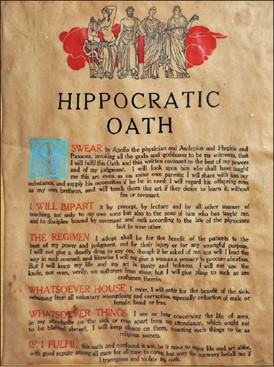
Source:
- Under new guidelines, Charak Shapath instead of Hippocratic oath for medical students
- No Hippocratic Oath, MBBS Graduates To Take 'Charak Shapath'
- What is Charak Shapath?
Image source:
RBI comes into existence
On April 1, 1935, the Reserve Bank of India was established in accordance with the provisions of the Reserve Bank of India Act, 1934. The Central Office of the Reserve Bank was initially established in Kolkata but was permanently moved to Mumbai in 1937. The Central Office is where the Governor sits and where policies are formulated. Though originally privately owned, since nationalisation in 1949, the Reserve Bank is fully owned by the Government of India. The Reserve Bank's affairs are governed by a central board of directors. The board is appointed by the Government of India. The origins of the Reserve Bank of India (RBI) can be traced to 1926, when the Royal Commission on Indian Currency and Finance – also known as the Hilton-Young Commission – recommended the creation of a central bank for India to separate the control of currency and credit from the Government and to augment banking facilities throughout the country. The primary role of the RBI, as the Act suggests, is monetary stability, that is, to sustain confidence in the value of the country’s money or preserve the purchasing power of the currency.
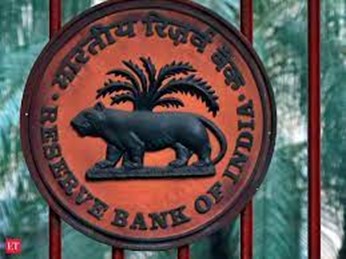
Sources:
National Strategy for Additive Manufacturing
In News
Recently, the Ministry of Electronics and Information Technology released the “National Strategy on Additive Manufacturing” to cater to next-generation digital manufacturing and mitigate immediate disabilities of local industries.
About Additive Manufacturing
- Additive manufacturing (AM) is a process of building three-dimensional objects by adding material one layer at a time.
- It is different from traditional manufacturing processes that are subtractive in naturee. the excess material is removed from a solid-block to get the final product.
- The design is developed on a CAD (Computer-Aided Design) system, converted into a three-dimensional model, and then using the AM process is replicated into a real-life 3D-object by depositing layer-over-layer of material till the object is created.
- Raw materials used are Thermoplastics like ABS, PC, PVA etc., Metals, Ceramics, Bio-materials.
- Although 3D printing is the most common type of AM process, there are other types of processes like Vat Photopolymerization, Directed Energy Deposition, Sheet Lamination, Material jetting, Powder Bed Fusion differing in the raw material used and the binding process employed.
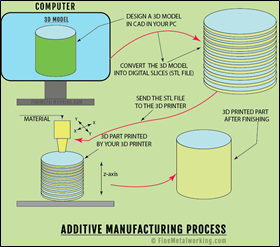
Need for development of AM in India
- Additive Manufacturing is ushering the world into an Industrial Revolution 4.0, offering immense potential that could revolutionize India's manufacturing and industrial production landscape through digital processes, communication, imaging, architecture and engineering that provide digital flexibility and efficiency.
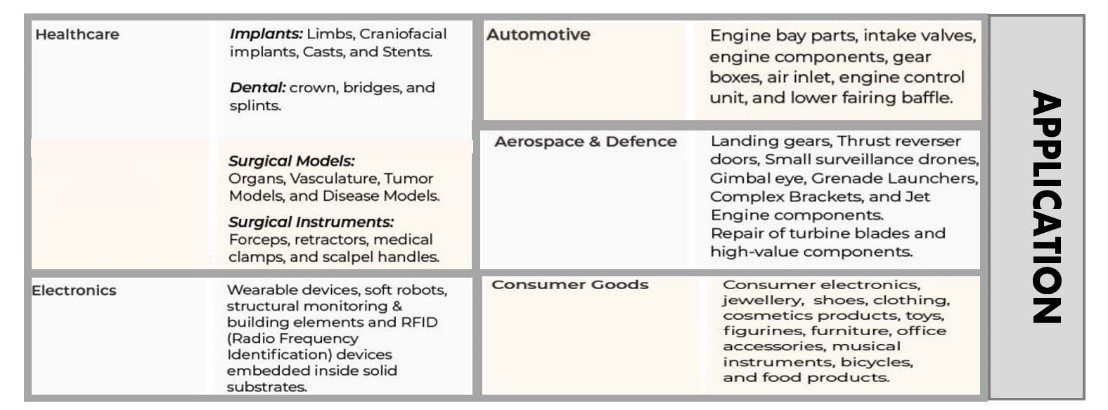

- Valued above US$ 7 billion in 2017, the industry is growing rapidly, and is expected to be at USD 35.6 billion by 2023.
- Considering that India is a major information technology services hub, it can achieve its true potential by adopting additive manufacturing.
- Artificial intelligence (AI) and Internet of Things (IoT) will play a key role in achieving these goals.
- Collective focus on Additive Manufacturing can immensely augment India's efforts to position itself as Manufacturing Hub of the world.
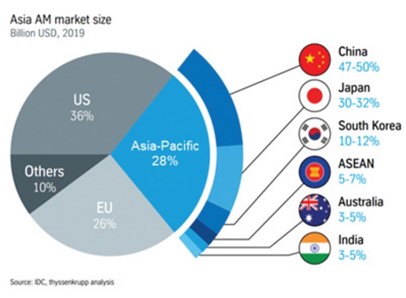
About the National Strategy for Additive Manufacturing:
Key Goals:
- The strategy aims to augment “Make in India” and “Atma Nirbhar Abhiyan”
- Position India as a global hub for Additive Manufacturing development and deployment.
- Increase domestic value addition in core and ancillary components, machines, materials and software.
- Reduce import dependency of domestic market by developing local skill, technology, scale of production etc.
- Establish a "National Centre on AM" for harnessing AM transformation and driving capabilities by continuously engaging all key stakeholders.
- Promote Innovation and Research infrastructure for commercialization of end-user application
- Strengthen India's collaborations with global AM organisations and Innovation and Research Centres.
- Develop long-term economic viability and market dominance of domestic AM companies in strategic sectors and areas of national security.
Strategy outcomes:
- The National Strategy for Additive Manufacturing aspires to enhance India's AM market share to 5% of Global market with a target to add nearly US$ 1Bn to the GDP by
- This growth will aspire to achieve the following specific targets:
- 50 India specific technologies for material, machine, process, and software to make India a 3D printed design and manufacturing hub.
- 100 new Start-ups, 1 Lakh new skilled manpower, 500 products
- 10 existing and new manufacturing sectors
- Awareness for adoption of AM products
India’s performance so far:
- In comparison to some of the leading countries across the globe such as the US, China, Germany and Japan, the adoption of AM hasn't seen as much traction in India.
- However, it has generated considerable interest in the Indian manufacturing ecosystem, due to its potential to support tremendous socio-economic growth.

- Government led efforts include multiple projects under Atal Innovation Mission, Establishment of 3D printing Manufacturing Lab at National Institute of Electronics & Information Technology, Aurangabad, collaboration of IISc Bengaluru (Additive Manufacturing for High Performance Metallic Alloys) with Wipro to build India's first industrial grade 3D printer
Challenges to adoption:
- Cost of Equipment & Material is high since most of it is imported for industrial use.
- As AM is still developing in India there is a lack of formal AM Standards.
- Service providers for AM are limited in India thus causing a lack of AM Ecosystem.
- Monopoly of AM market by foreign Original Equipment Manufacturers (OEM).
- There is a considerable lack of skilled manpower
- Domestic Market Transition will lead to various troubles like large vacated factory spaces and obsolete traditional manufacturing equipment raising questions on how to repurpose recycle or dispose of this infrastructure.
- Lack of clarity around the issue of liability may arise as the current laws and standards in the country are based on traditional manufacturing processes. For example, Additive Manufacturing could blur the lines between manufacturers and consumers as consumers themselves can manufacture goods for consumption.
- Several Legal and Ethical issues may arise like IPR, issue of bio-printing of organs etc.
Conclusion: Considering that India is a major information technology services hub, it can achieve its true potential by adopting additive manufacturing. India can make quick strides in material development and design if solid indigenous technology can be coupled with the right set of material supply chains, design know-how and economic strategies.
Question: What is Additive Manufacturing and why do we need a policy for it?
Sources:
World’s first single tower suspension bridge
This is image of the Lvzhijiang Bridge in China, which will be the world’s first single tower, single-span suspension bridge in the world when it opens to traffic next month. Stretching 798 metres over a Lvzhijiang (which literally translates as the “Green Juice River”), the bridge will make travel in the scenic and remote Yunnan province faster and easier. Built in a V-shape mountainous valley, the bridge is only held by one tower on one side and supported at both ends by cables, giving it a gravity-defying look and hailed as being an engineering marvel. It has surpassed the erstwhile record one-tower Jinshajiang Hutiaoxia expressway bridge, spanning 766 meters.
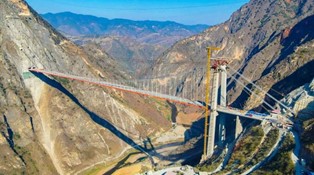
Source:
Aphasia
- Context: Famous Hollywood actor Bruce Willis, has recently after being diagnosed aphasia.
- Aphasia is a medical condition that affects a person’s ability to speak, write, and understand a language.
- It is a condition that essentially disrupts the brain’s filing system – where the people affected aren’t able to find the words they want to say, miss out words in their sentences, or come up with incorrect words, resulting in them speaking gibberish.
- They also have difficulty in understanding others.
- Aphasia can also be caused by loss of motor function, where one knows exactly what he/she wants to say but his/her brain does not give command to the tongue, so he/she is unable to say it.
- The condition is brought on by damage to the brain from a stroke, head injury, or a tumour, with stroke being the most common cause in India.
- It can persist as a disability in 21-38% of stroke survivors, with around 43 new cases being reported each year per 100,000 population.
- Depending on how the brain is affected and the pattern of impediments, aphasia can be categorised into three groups:
- Expressive aphasia, where the patient can understand others better than they can speak.
- Comprehensive aphasia, where the patient might speak in fluent complex sentences, but end up using unrecognisable words.
- Global aphasia, which results in poor understanding as well as difficulty forming words and sentences.

Source:
- Explained: Bruce Willis diagnosed with brain disorder aphasia, what is it?
- Bruce Willis Retiring Because of Aphasia Made Twitter Very Emotional
Image source:
‘FASTER’
- Context: The Chief Justice of India has recently launched ‘Fast and Secured Transmission of Electronic Records’ (FASTER).
- FASTER is a digital platform to communicate interim orders, stay orders, bail orders etc., of the Supreme Court to authorities concerned through a secured electronic communication channel.
- It would communicate the orders with the digital signatures of the Supreme Court officers and thus ensure privacy, safety and security.
- This initiative comes in the backdrop of delay in release of prisoners owing to the delay in physical orders reaching the prison authorities.
- The FASTER system is developed by the Supreme Court Registry in collaboration with the National Informatics Centre (NIC) to aid the cause of quick and effortless justice.
- To reach all districts of India through this system, so far 73 nodal officers have been nominated at various levels who have been connected through a specific Judicial Communication Network (JCN) by creating a secured pathway.

Source:
- Supreme Court goes ‘FASTER’ on delivery of orders
- CJI N V Ramana launches software to transmit court orders swiftly
Image source:
Maritime Rescue Coordination Centre
- Context: India and Sri Lanka have signed a MoU for the Indian public sector Bharat Electronics Ltd (BEL) to set up a state of the art Maritime Rescue Co-ordination Centre (MRCC) in Colombo.
- MRCCs are part of an international network under the UN’s International Maritime Organisation to monitor the sea lanes with the objective of swift response to emergencies, such as vessels in distress, rescue and evacuation of people, and prevention of and containing environmental disasters such as oil spills.
- Each country is responsible for its own Search and Rescue Region.
- The work of MRCCs is co-ordinated by the Navy or Coast Guard in each country. In India, the Coast Guard is the co-ordinating agency. In Sri Lanka, it is the Navy.
- The agreement between the two nations is significant as it enhances co-operation on maritime security between them in a part of the Indian Ocean region where the India-China rivalry has been a concern of late.
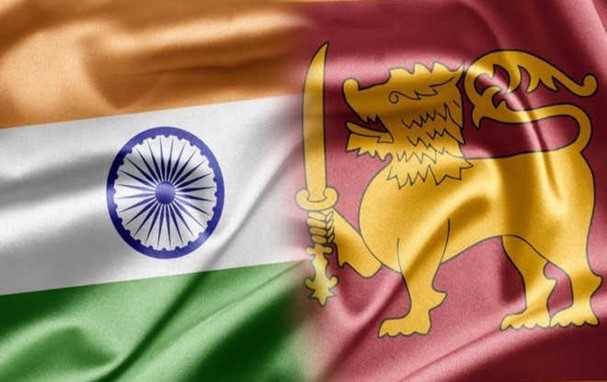
Source:
- Explained: Why India’s pact with Sri Lanka on a maritime rescue centre is significant
- Maritime Rescue Coordination Centre
Image:
This is a criminal attack on privacy: TH
Essence: As per the authors, Criminal Procedure (Identification) Bill 2022 undermines the privacy of not only persons convicted of crime but also every citizen as it proposes replacing Identification of Prisoners Act, 1920. The need for the bill is felt due to the limited definition of ‘measurements’ under the 1920 Act as suggested by the Law Commission of India (in its 87th Report) and the Supreme Court of India in State of U.P. vs Ram Babu Misra.
As per the authors, there are three expansions in the power of state surveillance in the Bill. First, the definition of measurements is not restricted to taking measurements but extended to their “analysis”. This could result in indirectly conferring legislative backing for techniques which may involve the collection of data from other sources. Second, The powers of the police and prison officials to collect “measurements” has been widened from persons convicted or persons arrested to to all persons who are placed under arrest in a case. Third, the provision which grants the National Crime Records Bureau (NCRB) permission to digitally store the “measurements” for a period of 75 years also permits NCRB to share and disseminate such records with any law enforcement agency and this may lead to surveillance.
Why should you read this article?
- To know about the need for the Criminal Procedure (Identification) Bill 2022.
- To understand how the bill will lead to increase in surveillance power of state.
Source:
Moving into an era of advertisements by digital avatars: ORF
Essence: Synthetic (or AI-generated) media is transforming the global advertising industry by cutting cost of creation of advertisement and making it more personalized. While the promise of this technology is immense, we must also be careful about its impact on consumer trust and safety of the products. Case in point is ‘NotJustACadburyAd’ by Cadbury where shopkeepers were empowered to personalize advertisements featuring Shahrukh khan. Consumers’ trust in the star was sought to be exploited without making sincere effort to verify quality of the product sold by their shops. This amounts to misleading consumers.
United States and European Union already have legal provisions in place to deal with this issue. It is need of the hour to update our law books to ensure accountability of these AI generated advertisements lest consumer loses trust in the ecosystem completely.
Why should you read this article?
- To understand potential and dangers of using Synthetic media in advertisement.
- To appreciate need to regulate use of Synthetic media in advertising.
Source:
India should step in to help Sri Lanka- it’s in our own interest: LM
Essence: Sri Lanka receives aid from India, Bangladesh, China, etc. in the form of line of credit, long term loans, currency swaps, etc. While its economy is going through a steep downslide, Sri Lanka’s foreign debt/GDP, inflation, fiscal deficit, current account deficit are skyrocketing and credit rating has downgraded. The cause of this crisis are- majoritarian chauvinism (loss of internal cohesion, civil unrest, avoidance of global capital), increased social sector spending- easy money policy post covid (with respect to hard infrastructure), over-reliance on single external benefactor, corruption, terrorism, economic mismanagement, loss in tourism, lesser exports (plantation, textile, etc.) and lesser remittances, etc.
Results have been loss of sovereignty over domestic territory (Chinese takeover of Humbantota port, Colombo Port construction, one country two systems, etc.), lesser FDIs, furthering the domestic socio-economic crisis. It is here where India should come to Sri Lanka’s aid to help them export spices, tea, help in providing IT/ITES business, agriculture, etc. and reap the rewards of stable, friendly neighbor.
Why should you read this article?
- To understand the major reasons for Sri Lankan crisis.
- To know the ways in which India could participate and provide relief to Sri Lanka, ahead of China.
Source:
Breaking the gender stereotype
Background
- The work of a crematorium worker is tough and it comes with heavy stigma around it, especially when you are a woman.
- Selina took up this job to support her family.
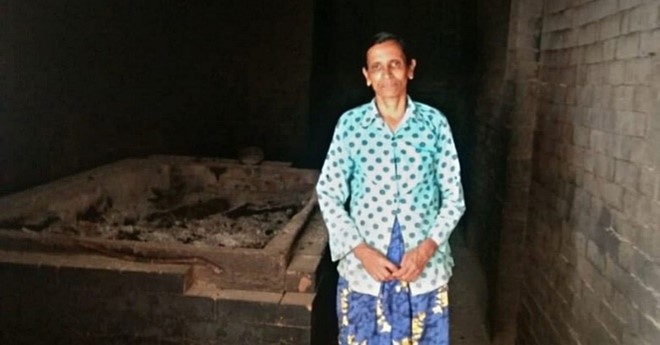
About Selina Michael: The female crematorium worker.
- Selina Michael, a resident of Kochi has been working as a crematorium workers since a decade now.
- She recalls the hardships that she has faced, starting with a difficult childhood and then an abusive and failed marriage.
- As she was the sole breadwinner of the family of two daughters, she had to do odd jobs like daily wage worker, but later got the job in the crematorium.
- She is often questioned for the job that she took up. But her need for survival is the answer to all these questions.
- Through this job, she earns a good income for her family to live a fairly decent life.
Quote: “Achieving gender equality requires the engagement of women and men, girls and boys. It is everyone’s responsibility.”- Ban Ki-Moon
Source:
Share the article
Get Latest Updates on Offers, Event dates, and free Mentorship sessions.

Get in touch with our Expert Academic Counsellors 👋
FAQs
UPSC Daily Current Affairs focuses on learning current events on a daily basis. An aspirant needs to study regular and updated information about current events, news, and relevant topics that are important for UPSC aspirants. It covers national and international affairs, government policies, socio-economic issues, science and technology advancements, and more.
UPSC Daily Current Affairs provides aspirants with a concise and comprehensive overview of the latest happenings and developments across various fields. It helps aspirants stay updated with current affairs and provides them with valuable insights and analysis, which are essential for answering questions in the UPSC examinations. It enhances their knowledge, analytical skills, and ability to connect current affairs with the UPSC syllabus.
UPSC Daily Current Affairs covers a wide range of topics, including politics, economics, science and technology, environment, social issues, governance, international relations, and more. It offers news summaries, in-depth analyses, editorials, opinion pieces, and relevant study materials. It also provides practice questions and quizzes to help aspirants test their understanding of current affairs.
Edukemy's UPSC Daily Current Affairs can be accessed through:
- UPSC Daily Current Affairs can be accessed through Current Affairs tab at the top of the Main Page of Edukemy.
- Edukemy Mobile app: The Daily Current Affairs can also be access through Edukemy Mobile App.
- Social media: Follow Edukemy’s official social media accounts or pages that provide UPSC Daily Current Affairs updates, including Facebook, Twitter, or Telegram channels.

